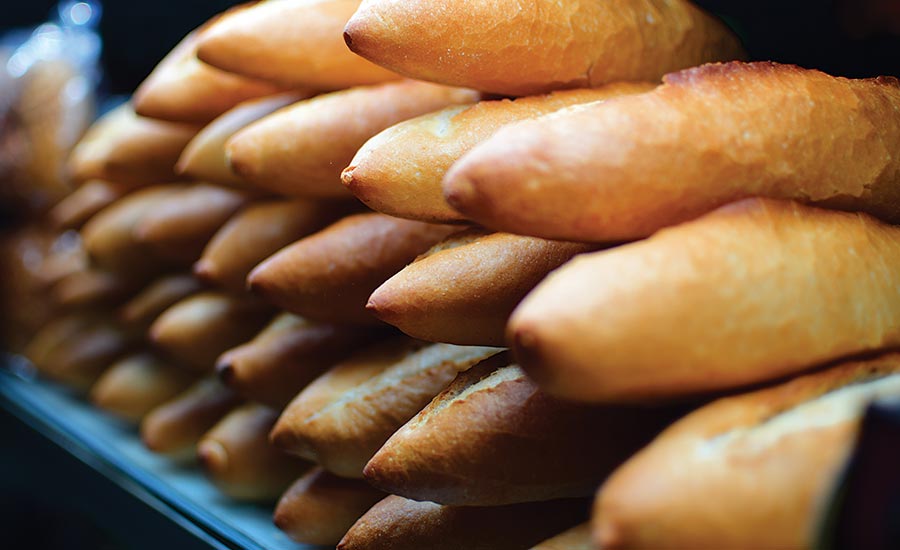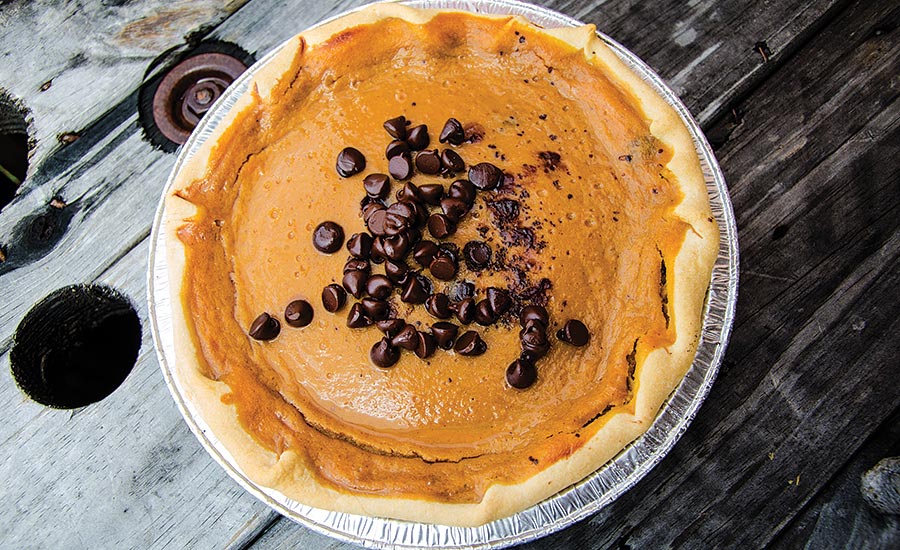2018 State of the Industry: Defining the future of foodservice
The snack foods and baked goods distributed to foodservice continue to align with prevailing flavor, format and functional trends shaping the industry

The scope and variety of snack foods and baked goods continues to evolve across the U.S. foodservice landscape. Snack producers and bakeries, often working in collaboration with restaurant operators, continue to work to build interest and intrigue across all dayparts—including the omnipresent snacking segment—while still remaining comfortingly familiar. It’s a delicate balance, and understanding customer motivations and emerging menu trends is the first step.
Breakfast
Breakfast gained renewed interest when operators began expanding its availability across all dayparts. “The number of restaurants offering breakfast continues to grow each year, which means there could be a real opportunity for shareable breakfast appetizers,” says Mike Kostyo, senior publications manager, Datassential, Chicago. He suggests ideas like mini scones or pancake-wrapped sausages and french toast sticks with a maple cream cheese dip.
“All day breakfast concepts are trending, and potatoes are a breakfast staple that can even be instrumental in putting a new twist on a classic dish, like a savory potato waffle, for example,” says R. J. Harvey, RDN, CEC, global foodservice marketing manager, Potatoes USA, Denver.
Breakfast sandwiches continue to grow in menu penetration, notes Kostyo. “Today, nearly a quarter of fast casuals offer them.” Brioche is the fastest-growing carrier in breakfast sandwiches, up 66 percent in the past four years, followed by flatbreads, buns and biscuits, reports Datassential. “With options like brioche and biscuits growing overall on menus, there is an option for operators to cross-utilize these products across the menu.”
Datassential notes that the menu descriptor “gooey” saw the most growth for breakfasted baked goods and pastries in the past year, often used with items like honey buns, cinnamon bites, monkey bread or pecan buns. “Breakfast pastries have really been experiencing phenomenal growth recently,” says Kostyo. “Cinnamon rolls and doughnuts are some of the top-growing options on menus.”
Yogurt grew 80 percent in breakfast baked goods and pastries in the past year, per Datassential, including when used as an ingredient in items like “bran muffins made with yogurt” or “Greek yogurt breads.”
Snacks/appetizers
Almost all of us snack during the course of the day—upward of 95 percent of U.S. consumers. And Datassential notes that 62 percent of consumers say anything can be a snack.

Datassential is the Snack Food & Wholesale Bakery “State of the Industry— Foodservice” menu trends partner
But restaurants haven’t fully capitalized on the snacking movement. “Operators are missing the snacking opportunity,” says Kostyo. “While nearly all operators say they have something on the menu that could be considered snackable, only a third specifically menu them as snacks or shareable options.”
In many cases, the answer is already on the menu. “During the majority of the day, consumers are likely to be snacking on a dish that would normally be considered an entrée, like a slice of pizza, a burrito or a burger,” says Kostyo. “Offering snack-sized portions of entrées can also create a ‘best of both worlds’ opportunity for customers, where offering a plate of those mini options with a side turns them back into an entrée.”
Matthew Boring, executive chef, Tyson Foods, Springdale, AR, notes that QSR has been a focal point for trend activity. “In the appetizer world, tacos, wontons and bao buns are becoming increasingly popular.” This fits with the goal of bringing smaller and appetizer portions to the table. “Ethnic flavors and spices are really showing increasing popularity, especially around African flavors like harissa.”
Small is big, and sliders have been the fastest-growing appetizer option on menus over the past four years, notes Datassential. “Now that they are becoming the norm on appetizer menus, there is an opportunity to stand out and take them to the next level with premium breads and carriers,” says Kostyo. “Think about options like a kálua pork slider on a Hawaiian roll or a chickpea fritter on an ancient grain mini bun.”
Mark Stavro, senior director of marketing, Bunge North America, St. Louis, notes that one of Mintel’s top three foodservice trends for 2018 is “Foodceuticals”—menu items that focus on consumer well-being. “Whole and ancient grains fall into this category perfectly, because consumers perceive them as being quality nutrient sources, offering fiber and protein. Bunge’s ancient grains are Non-GMO Project Verified and available in a variety of formats, including grits, meals and flours.”
Kostyo also suggests working with operators to bring a bit of better-for-you snacking onto the menu, such as incorporating salty, crunchy snacks with healthy attributes, like nachos that feature whole-grain tortilla chips.
Restaurant patrons are also concerned about the health of the planet. “Sustainability has become an increasingly important topic with consumers because of their interest to know more about how their food is produced,” says Dave Booher, Corteva Agriscience, agriculture division of DowDuPont, Midland, MI. A recent company survey found QSR patronage would increase by “using environmentally friendly oil.” He notes that Omega-9 Canola Oil is a more-stable option than other common cooking oils and doesn’t need to be changed as frequently in frying applications. “This longer shelf and oil life means less waste.”
The survey also found that more than half of QSR patrons would increase visits to restaurants if “healthier oils” were promoted. Omega-9 Canola Oil has high levels of monounsaturated fats, zero grams of trans fat and low levels of saturated fat.
“I’ve seen a 4 to 11 percent reduction in calories in foods fried in high-oleic soybean oil versus conventional soybean oil due to higher moisture retention and lower oil uptake,” says Pam Smith, R.D., program consultant, United Soybean Board, Chesterfield, MO.

Pizza
Pizza is America’s favorite food, and the crust can make or break it. “When we asked consumers what the most-important part of a pizza is in a report a few years ago, they overwhelmingly chose the crust,” says Kostyo. In fact, more than twice as many consumers said a great pizza starts with a great crust.
Datassential notes cracker-thin Neapolitan-style pizzas and wood-fired pizzas have become common. Also, Detroit-style pizza, a pan style with crispy edges, has been trending recently, with 64 percent of consumers interested in it—but with less than 1 percent menu penetration.
Other options include breakfast pizza (up 63 percent on menus over the past four years) and gluten-free (up nearly 300 percent on menus over the past four years). “Gluten-free potato, cauliflower, and chickpea pizza crusts and flatbreads are becoming more prevalent on menus,” says Harvey.
“Pay attention to pizza trends that can be leveraged in the crust itself,” suggests Kostyo. “Ingredients like sriracha, chili flakes and vegan cheese have all been growing on pizza in the past year, and they could be leveraged in crusts with sriracha glazes, chili flake dusts or a vegan cheese inclusions.”

Sandwiches
“We are seeing consumers looking to make better food choices and to get more out of their snacking occasion—whether it is a food packed with protein, perceived as more natural, such as made from less-processed ingredients, or offering additional nutrients,” says Nancy Todys, director, c-store and vending, channel development, Tyson Foods. “Consumers still consider almost anything a snack. Sandwiches and wraps can be snacks. It is about satisfying that craving and hunger between meals.”
While the fastest-growing sandwich carriers in the past four years are brioche, pretzel rolls and biscuits, per Datassential, ethnic sandwiches hold significant promise.
Bread carriers are a great way for restaurants to add ethnic flair to menus, says Catherine Porter, director of foodservice marketing, Grecian Delight, Elk Grove Village, IL. She notes naan is gaining popularity on restaurant menus, including as a pizza crust or sandwich carrier.
“The real trend in sandwiches over the past four years has been the growth in globally inspired sandwiches,” says Kostyo. “The bánh mì, for instance, grew nearly 200 percent on menus in the past four years, while the second fastest-growing sandwich was the Mexican torta.” He notes Cuban sandwiches are also among the fastest-growing sandwiches.
The popularity of bánh mì and tortas opens a market for authentic carriers, such as Vietnamese baguettes (a light and airy crumb with a lightly crisp crust) and Mexican bolillos (similar to baguette dough but slightly sweetened). Pan Cubano adds some fat to the dough.
And then there is the tortilla. “Wraps are nearly as common as bread as a sandwich carrier at QSRs and fast-casuals today,” says Kostyo.
Flour tortillas have been declining slightly on menus since peaking in 2010, while corn tortillas have been steadily growing, notes Datassential. “This has been driven by a desire for more-authentic options and the growth of street tacos, which increased their menu penetration 145 percent in the past four years,” says Kostyo.
“Ethnic flavors are trending right now, and authenticity is key,” says Stavro. “They look for foods that provide a specific provenance and original flavor experience—flavors from individual regions of Mexico, China and more.”
Bunge recently acquired Minsa’s U.S. mills, expanding its portfolio of corn masa flours to include yellow and white, vibrant colors, and non-GMO and organic options. “Tortilla manufacturers can now look to Bunge as a single source for all of their tortilla ingredient needs, including high-quality masas, shortenings and oils.”
Starvo points to the growing demand for transparency of ingredients used at restaurants, creating the need for foodservice operators to add claims to their menus. “To help our foodservice customers meet this need, many of Bunge’s grain and oil ingredients are available in Non-GMO Project Verified, USDA certified organic, and certified transitional organic options.”
These health halos bring health and wellness into the picture. “Millennials are having children and want their children to eat healthier,” says Peggy Castaldi, director of marketing, SupHerb Farms, Turlock, CA. “This is driving the growth of organic, transparency and ‘clean’ food across all foodservice segments.”
This demographic emphasis skews even younger. “Generation Z has been educated from the time they entered school about the importance of health and nutrition,” says Castaldi. This translates into a higher percentage of Generation Z following a specialized diet, like vegan or vegetarian, compared to the general population.
Bringing ancient grains onto the menu communicates a nutritional and clean message. Porter notes Grecian Delight’s Flatwraps work well as an upscale tortilla replacement, adding European flair, and that the line now includes a new Ancient Grains variety.
Mini sandwiches are also on Porter’s radar. “Mini breads, like a 4-inch pita pocket or Flatwrap, enable restaurants to meet consumers’ desire for smaller, snack-size items like sliders or samplers. This is especially important with ethnic items, as restaurant patrons have a lower risk to try something new with smaller, sampler sizes.”
Sprouted is also starting to hit menus. “Over a third of consumers are interested in sprouted-grain bread, which a few trend-forward chains have adopted,” notes Kostyo.
“Consumers have started to expect the foods they consume—be it at home, at school, at work, or anywhere else—to be healthier,” says Paul Verderber, vice president of sales, Carolina Innovative Food Ingredients (CIFI), Nashville, NC. “That has paved the way for unique ingredients like our sweet potato juice concentrates and flours.” He suggests that a turkey and cranberry sandwich on a sweet potato bread or bun would work as an LTO menu item with seasonal and artisanal appeal.

Desserts
Many of the most-common desserts on menus—cake, cheesecake, cupcakes and pie—have been declining on menus over the past four years. “It may be time to add some excitement to these menu items and consider new flavors or formats,” says Kostyo.
Sweet potato pie was the fastest-growing pie variety on dessert menus in the past year (up 23 percent on dessert menus), and it was one of the fastest-growing desserts overall. “Now we’re seeing unique versions showing up on menus—gingerbread crusts, bourbon glazes, etc.,” says Kostyo.
“We’re seeing a lot more savory flavors show up in desserts,” says Kostyo. “Corn, in particular, grew nearly 20 percent on dessert menus in the past year in options like corn cookies or blueberry corn cakes.”
Operators report that their biggest challenge for desserts is controlling food costs. “Manufacturers should focus on the ways that their products answer these concerns,” suggests Kostyo.
Looking forward
When striving to bring more adventuresome potential to menus without polarizing customers, Porter recommends starting small. “Appetizers, snacks and sides are a great way to start consumers off on new ethnic or adventurous items without the perceived risk to their main meal. These menu parts are where consumers want to experiment.” She suggests falafel as a snack item, perhaps as a snack wrap.
“The second way we like to encourage restaurants to approach new flavors and products is what we call the ‘ethnic flair for comfort food favorites’ approach,” says Porter. “For example, take a classic item like a turkey and Swiss melt, but use a pita or a panini flatbread as a carrier to give the consumer something they know and like, but in a slightly different way that can add a fun or unique twist.” Or operators could offer a personal pizza, but on a pita or naan.
“Six years ago, SupHerb Farms launched a Moroccan harissa sauce,” says Castaldi. “A majority of consumers had no idea what it was. Fast-casual operators, especially bakery-cafés and coffeehouse chains, were hesitant to use the item, even though they loved its flavor. We recommended describing it as a ‘Mediterranean sauce’ and calling out a few key ingredients that were familiar to consumers. They agreed and menued their breakfast and lunch sandwiches as a ‘Mediterranean bagel sandwich’ with a jalapeño bagel or a ‘Mediterranean wrap’ with a red pepper tortilla, highlighting the red peppers and jalapeños in the harissa.” The strategy worked, and customers loved the new sandwiches. “As consumers became more familiar with harissa, the operators began calling out harissa on menus.”
Health also shows considerable promise in foodservice today. “Soybean oil is recognized by the FDA as heart-healthy and is the most-commonly used oil in U.S. restaurants today,” says Stavro. “In an effort to build awareness of its heart-health benefits and to give restaurants the opportunity to market them, Bunge independently petitioned the FDA to approve a qualified heart-health claim for soybean oil. Now, following the FDA’s approval of the claim, foodservice operators are better positioned to market heart health on their menus.”
Snack food producers and bakeries clearly have a wide range of opportunities for collaborating with foodservice customers to meet the prevailing trends gaining traction in foodservice today.
Looking for a reprint of this article?
From high-res PDFs to custom plaques, order your copy today!






